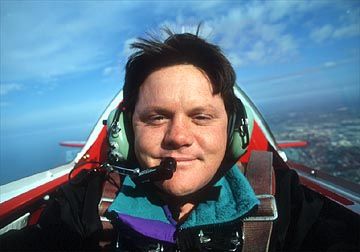 Michael Fizer was born February 14, 1959, in Phoenix, Ariz. Mike’s dad flew F-100s in the Air Force and Mike had his sights on the Air Force Academy to follow in his fathers footsteps. In 1974, at the age of 15, Mike received his first camera for his birthday. On his first photo shoot he went with a friend to shoot him riding motorcross. During the shoot his friend proceeded to take a blind jump and land on Mike. For the next six weeks Mike was hospitalized with multiple fractures. Mike spent the time in traction, and later in a body cast, reading more on photography.
Michael Fizer was born February 14, 1959, in Phoenix, Ariz. Mike’s dad flew F-100s in the Air Force and Mike had his sights on the Air Force Academy to follow in his fathers footsteps. In 1974, at the age of 15, Mike received his first camera for his birthday. On his first photo shoot he went with a friend to shoot him riding motorcross. During the shoot his friend proceeded to take a blind jump and land on Mike. For the next six weeks Mike was hospitalized with multiple fractures. Mike spent the time in traction, and later in a body cast, reading more on photography.
He began his career emphasis of aviation in 1978 as an assistant with noted aviation photographer Paul Bowen. Five years later, he started is own freelance photography business, contracting with aviation manufacturers and other Wichita area businesses for both location and studio photography. Mikes editorial photography background began with Flying magazine in 1985. He was hired as Staff Photographer for AOPA Pilot magazine in 1988. Mike is also president of Fizer Photography, which maintains an awesome searchable portfolio of Mike’s aircraft, landscape, weather and studio work.
In 1995, Mike was selected by Canon U.S.A. Inc. to join their prestigious Canon 55 group, which recognizes professional photographers around the world for their contributions to commercial photography. Mike is still a member of this elite group, and it is through their sponsorship and AOPA that Mike is now recognized as a prominent speaker for public educational seminars in both aviation and aerial photography.
Tell me about your dad and growing up in an Air Force family.
My dad was in the Air Force from 1951 to 1971. He flew F-84s, F-86s and F-100s and taught ACM at Luke AFB. I was born in Phoenix, went to the Philippines, back to Phoenix, went to Louisiana, back to Phoenix, went to Libya, then back to Phoenix. We lived in Libya when Gaddafi overthrew the government. It wasn’t violent, they just asked us to leave. Living overseas I got to see real poverty, and I came back to the U.S. from North Africa at age 11 with a great appreciation of what we have here.
When my dad retired from the Air Force in 1971, he sat around for about six months … going crazy. One day he took us out to the airport to show us a mockup of a Citation 500. He called Cessna and they needed pilots, and he was the fourth pilot hired for the Citation division. He ended up being chief pilot and manager of operations, and retired from Cessna in 1991.
Growing up I really did want to be a fighter pilot, but after the motorcycle accident I was laid up for a while and got hooked on photography.
Did your dad offer to teach you to fly?
After I got into photography, I never had an inkling to learn to fly. My dad wasn’t going to push it on me. Years later I expressed an interest, and my dad said "You should have said something!"
We fly together a lot. When we don’t have a formation pilot and the shoot is within driving distance, dad and I will load up the van and head off on a father-son outing. My dad doesn’t have his medical, so another pilot takes off and lands, and dad flies the formation work. He has no interest in flying other than working with me.
How did you learn about aviation photography?
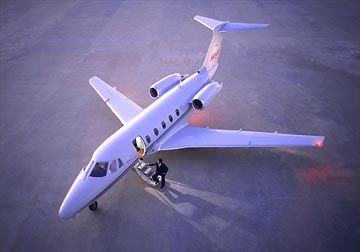 I got a camera when I was fifteen. My buddy had a brand-new motocross bike, so we went out to some local hills. Hills are rare in Kansas, but we have a few. My friend went over a blind jump of about 60 feet and center-punched me. He was going about 60 miles an hour and tangled my right leg in his motorcyle. I was in traction for about 10 weeks and another 10 weeks in a body cast. I spent that time reading about photography. My parents set up a darkroom in the basement and by then I was hooked. I didn’t think the Air Force was going to take me after what I had been through with my hips, my legs and my ankles.
I got a camera when I was fifteen. My buddy had a brand-new motocross bike, so we went out to some local hills. Hills are rare in Kansas, but we have a few. My friend went over a blind jump of about 60 feet and center-punched me. He was going about 60 miles an hour and tangled my right leg in his motorcyle. I was in traction for about 10 weeks and another 10 weeks in a body cast. I spent that time reading about photography. My parents set up a darkroom in the basement and by then I was hooked. I didn’t think the Air Force was going to take me after what I had been through with my hips, my legs and my ankles.
Through high school I was your typical darkroom nerd. I worked on the newspaper and the yearbook. In my senior year I took a semester off and interned with Jim Myers, who was an assistant to [noted aviation photographer] Paul Bowen. After that I decided I wasn’t going to college. You go to a university or photo school and pay them $20,000 a year and you come out with a portfolio and a piece of paper. I figured I could be an assistant and make $20,000 a year and come out with a portfolio.
After high school, I worked at a lab in Wichita and wound up printing most of Paul’s work. After a year of that, I went to Tuscon to the Center for Creative Photography. I had no intention of getting a degree, but there were some people there I respected, and I wanted to hone my skills in the fine-art area. While I was there, Paul had a shoot with Learjet in Tuscon, and I assisted. Paul needed an assistant, so I left the fine-art scene, took that job, treated it as school, and spent three and a half years with Paul. It was great experience. I was responsible for certain accounts — FlightSafety International was one of them — and to be 19 and traveling around, making decent money for a kid my age, was just a hoot.
After I left Paul, I had to sit out our non-compete agreement for a year. I went back to Tuscon until I ran out of money, then came back to Wichita and managed a one-hour lab for a year. I realized I wanted to be my own boss and hit my dad up for co-signing a loan. Three days after we set up shop and opened for business FlightSafety called. They had taken their photography operation in-house but they were so busy that they needed outside shooters and they remembered me. It wasn’t a huge account, but between that and some studio work I was able to survive.
How did you get to Flying magazine?
By about 1985, my dad was pretty far along at Cessna — at that time he was manager of flight operations. He would come back from a trip and hand me Dick Collins’ business card. I had met Dick through working with Paul, and Dick told my dad to have me call about some work. I didn’t call because I figured that Flying had Bowen and they didn’t need me. A month or two later the same thing happened. Dick told my dad, "Have him call me." About the fourth time this happened, my dad barked at me and I called. Three weeks later I got a job with them.
Paul and I handled the Midwest for Flying from ’85 to ’88. I really hadn’t planned on being an aviation shooter. I figured because of the nature of Wichita I’d get some of it, but I really love studio work. Then in ’88 Dick Collins went to AOPA Pilot and offered me some work there. I liked working for Flying because it was on the newsstand, then Dick offered me the whole magazine. You just don’t pass up the opportunity to have a whole book to yourself.
We worked out an agreement that I would be able to stay in Wichita, as an employee, yet still operate as a free-lance photographer.
How much do you travel?
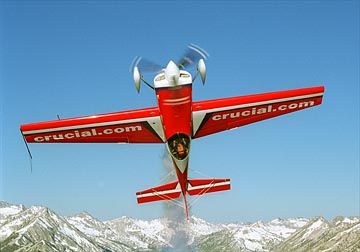 For the past 12 years I’ve been on the road between 10 and 14 days a month. So I’ve lost most of my local non-aviation studio work. When you’re not here to do it, they find somebody else. But I’ve stayed at the magazine because I love the people. They give me a lot of freedom and very seldom tell me "no."
For the past 12 years I’ve been on the road between 10 and 14 days a month. So I’ve lost most of my local non-aviation studio work. When you’re not here to do it, they find somebody else. But I’ve stayed at the magazine because I love the people. They give me a lot of freedom and very seldom tell me "no."
At some smaller publications — and even some larger ones — you have to get the shot even if the weather’s bad. At AOPA there have been times when I’ve stayed an extra three or four days to get the right shot. That’s rare. I tip my hat to the three editors I’ve worked for — Dick Collins, Mark Twombly, and Tom Haines — and the art directors — Art Davis and Mike Kline — for giving me some rope.
Let’s walk through the process of a shoot. How do you scout locations,brief the formation pilots, and decide what you can shoot that day based on theweather?
For background, we usually take what we can get in the general area. For instance, Cirrus is in Minnesota. Lancair is in Bend, Ore., which has beautiful scenery. If the shoot’s around Wichita, there’s not that much for background. If we have the time, we’ll head down to Grand Lake, Okla., just to get something different. I usually arrange the aircraft for the photo platform. My favorites are the Bonanza A36, the PA-32 — either a Saratoga or a Cherokee Six. The Duchess works very well. I stay away from some Cessnas because of the wing and the windows. I never shoot through glass, but we pop the doors off of the 206 and the 207 and those work very well. The Baron 58 works well — anything you can get a big hole in the side of. For AOPA, the writers usually fly the company Bonanza.
Most of the airplane manufacturers have formation-trained pilots. If the writer for the story is not available, then we usually use the factory pilots. If they’re not available, we don’t fly. It’s as simple as that. I tell everybody what I want and the pilots discuss what they can do, agree on speeds, break procedures, comm frequencies, altitudes. Like all formation flying, it’s the lead’s responsibility to keep us out of the dirt, watch for obstacles, traffic, and handle ATC communications.
I run into aerobatic pilots or military pilots who are great formation pilots but not photo platform pilots. It’s a different kind of formation flying. Instead of being 15 or 20 feet away, you’re out at 50 yards. There’s an adage — it may have come from Paul Bowen — that if the sun isn’t in your eyes and your neck doesn’t hurt, you’re not in the right spot. I warn the newcomers that by the end of the day they’re going to hate me, because I’m going to put them into positions that just aren’t comfortable.
If we arrive mid-morning I’ll get started on the interiors, because the light’s not real pretty in the middle of the day. Then at the end of the day we’ll work on ground shots and finish the day with the air-to-air shots. If we’re starting in the morning we reverse it — do the air-to-air shots first, then the ground shots, then the interiors and panels. It’s almost a formula, except the background and the light are constantly changing, and that’s what gives you variety. It’s like sports photography — you have to capitalize on the moment — but it’s unlike sports in that you can frame and compose the picture by using the background. So it’s a little bit of both. We do a lot of straight- and-level 360s, trying to get a variety of angles of sun on the airplane, and I’m constantly moving the airplane around in flight.
How do you move the airplane around?
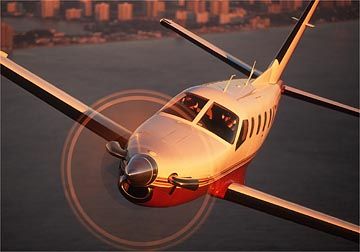 I use hand signals. I have signs for forward, back, left, right, up, down and one for "that’s good." I try and anticipate where I want the airplane and give him a "that’s good" when he gets there. We always use intercoms so if there’s something specific I need I’ll ask my pilot and he’ll relay it to the other pilot.
I use hand signals. I have signs for forward, back, left, right, up, down and one for "that’s good." I try and anticipate where I want the airplane and give him a "that’s good" when he gets there. We always use intercoms so if there’s something specific I need I’ll ask my pilot and he’ll relay it to the other pilot.
I work with a gyro-stabilizer and two cameras. I generally will switch cameras and reload when the sun is in my eyes in a 360. That’s generally the time you wouldn’t want to shoot, and if the sun’s in my eyes the pilot can see me. In the low light, you do want to shoot into the sun for the mood stuff when the sun’s a little hazy. That’s when you get that glassy, backlit, nice soft feel.
How long are you in flight for a typical shoot?
About an hour, maybe an hour and a half. Two hours for a long one. For everything — ground shots, interiors and air-to-air, I shoot between 18 and 25 rolls of 36-exposure, and out of that we’ll use maybe eight pictures. A good third of it ends up in the trash. I usually send 60 to 80 pictures to AOPA, and I keep about that many. There’s so much motion and I’m very critical about sharpness, so I go through the whole roll with an eight-power loupe. On 35 mm, that’s the only way to tell if it’s razor sharp. Anything that isn’t sharp goes in the trash. Then I use a four-power loupe for composition because you can’t see the whole frame with an eight-power. Between aesthetics and sharpness, about a third of it goes into the trash. But that still leaves a couple hundred good pictures.
What’s keeping you from switching to a digital camera?
For some projects they’re great. There are two problems for what I do: capacity and writing speed. Let’s say a full spread in AOPA is a 60-megabyte file. Let’s say with today’s interpolation programs to kick the resolution up you need a 30-megabyte file. I shoot five or six frames a second, so I would need a 200 megabyte per second writing speed, and we’re not there yet. And since you’d rather not interpolate up, you need something closer to 700 megabytes per second. In every other aspect they’re great cameras. It’s changing so quickly that it’s just a matter of time.
I don’t hold any great allegiance to equipment, the hardware, or the technology. The image is the important thing. If I can get down to one little camera and one lens and never having to reload, I’ll be happy to move on.
Does motion photography interest you?
I’ve done a little bit of video, but not much. Most of what I see in aviation is wide-angle stuff, and they do that because of camera jitter. But the smaller three-chip video cameras — like the Sonys and the Canons — are borderline broadcast quality and they’re small enough that you can put them on a gyro-stabilizer. That lets you zoom out and get the 200-mm shot without the jitters. You can do that now with the Clay Lacy equipment but you have to spend thousands an hour to get it. So, again, it’s just a matter of time before the technology catches up so the average person can take advantage of it.
Do you like working from a helicopter?
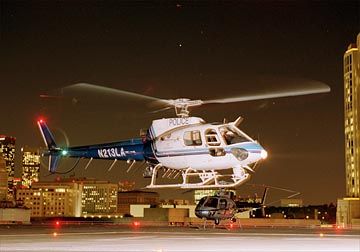 I have shot from them and it’s a little harder because of the shimmy that you get just from the nature of choppers. Slower shutter speeds help, but turbine helicopters turn slower than pistons, so it’s hard to get a full prop arc on a helicopter. At a 60th of a second, with a four-blade, you might be okay, but with a two- or three-blade you’re not going to get it. Sometimes I use a long lens and crop the rotors out, and use a cockpit shot. You can’t shoot up as much, because of your own rotors.
I have shot from them and it’s a little harder because of the shimmy that you get just from the nature of choppers. Slower shutter speeds help, but turbine helicopters turn slower than pistons, so it’s hard to get a full prop arc on a helicopter. At a 60th of a second, with a four-blade, you might be okay, but with a two- or three-blade you’re not going to get it. Sometimes I use a long lens and crop the rotors out, and use a cockpit shot. You can’t shoot up as much, because of your own rotors.
I gave Tim McAdams, a freelance writer for AOPA Pilot, some hints once … and darn it, he went out and did it — and did it well — so I don’t get to do helicopters so much anymore.
It’s not that different from fixed-wing. Again, I can’t stress the importance of a good formation briefing.
Can you give us a photo shoot war story?
I got booked for a session with a Stinson and a Champ. I had been told that these guys knew how to fly in formation, so I went. When I got there and talked to them about the formation, I got just a little "hair on the back of your neck" sensation … but not enough to cancel. The terrain was a challenge. We were flying out of a grass strip in Missouri, and we’re flying in a canyon with power wires. Then on the base leg you’re staring into a mountain, and just about the time you think you’re going to hit the hill, you turn left and fly over some trees to land.
We lost radios on final, but we had briefed about lost comm and I figured the other guy would fly the pattern. That’s what we briefed. I told the pilot we had to get closer, because we just weren’t getting the shot. So he closed the gap as we turned base to final, and we were closing fast. He pulled up to slow down, then I could see him looking over the right side of the airplane, then his head popped up and goes left, goes right, goes left, and I realize he’s lost visual contact. When I peek over the edge I see wings right under our wheels. It seemed like inches, but I know it wasn’t any more than two feet. I started yelling "break up!" at the top of my lungs and finally he did. I’ve been through a few of those types of things, but not for a long time … and that’s because I just won’t fly with someone who flies like a hot dog. I don’t question their ability to handle an airplane, but that attitude isn’t going to work for a photo mission.
If you ask someone about their formation flying and he starts bragging, don’t fly with him. My dad flew formation for almost 20 years, and flew about 100 photo missions for Cessna. He told me, "The guy who barks the loudest is the one that’s going to kill you," and that’s been absolutely great advice.


































